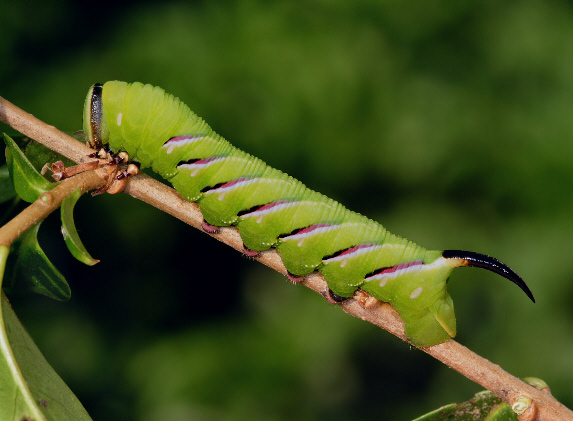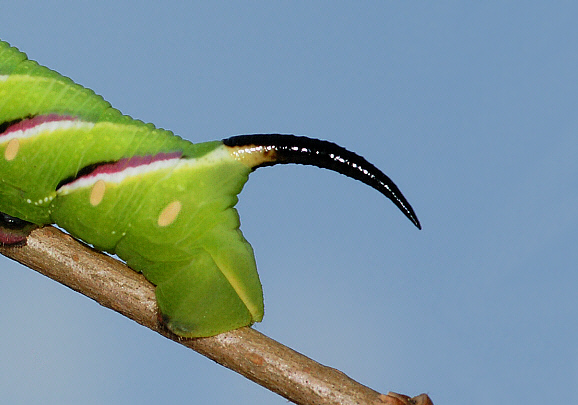
Sphinx ligustri, Hampshire, England – Adrian Hoskins
Introduction
The family Sphingidae comprises 200 genera and about 1200 known species worldwide of which 16 species have been recorded in the British Isles, and 125 in North America.
They are known as Hawk moths due to their hovering hawk-like flight. In the USA they are known by the alternative name Sphinx moths – this refers to the behaviour of the caterpillars which often rest with their heads raised in a sphinx-like posture.
Habitats
Sphinx ligustri is distributed throughout temperate regions of Europe and Asia as far east as Japan. It breeds in open-scrub and woodland-edge habitats and is most abundant on calcareous ( chalk / limestone ) hills where wild privet grows in profusion. other habitats include alpine valleys, and suburban zones where privet is grown for hedging.

Sphinx ligustri, Hampshire, England – Adrian Hoskins
Lifecycle
Caterpillars of species in the subfamilies Sphinginae and Smerinthinae are usually marked with a series of diagonal stripes on the abdominal segments, and have a curved horn at the tail end. This horn is quite soft to touch, and despite popular myth does not sting. In some tropical species the horn is much longer and thinner, and can be used as a whip to discourage attack by parasitoid wasps and flies. The function of the shorter horn found in most temperate zone species is unknown.
This species feeds as a caterpillar on privet Ligustrum vulgare, ash Fraxinus excelsior, Virburnum sp, Spiraea sp, and occasionally on Holly Ilex aquifolium and other plants.
The caterpillar is attacked by many species of parasitoid wasps including Amblyjoppa fuscipennis, Apechthis compunctor, Apechthis rufata, Callajoppa cirrogaster, Callajoppa exaltatoria, Goedartia alboguttata, Ichneumon insidiosus, Pimpla turionellae, Protichneumon fusorius, Protichneumon pisorius, Therion circumflexum; and by parasitoid flies including Compsilura concinnata, Frontina laeta, Huebneria affinis, Masicera sphingivora, Nilea hortulana, Phryxe nemea, Phryxe erythrostoma and Winthemia cruentata.Pupation takes place on the surface of the ground amongst mosses and leaf litter, or in loose soil just below the surface of the ground. The pupae are dark reddish-brown in colour, and have the proboscis raised proud of the surface like a jug handle.
Adult
The forewings of this large ( 90-120mm wingspan ) species are patterned in shades of brown, grey and blackish, giving the moth a strong resemblance to a broken woody stick. This provides it with excellent camouflage when it is at rest on fence posts or tree trunks. The body is hidden beneath the wings at these times, but if disturbed the moth spreads the wings to reveal the abdomen, which is banded in pink and black.
